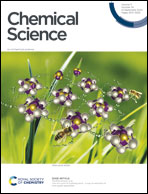Metal–ligand bond strength determines the fate of organic ligands on the catalyst surface during the electrochemical CO2 reduction reaction†
Abstract
Colloidally synthesised nanocrystals (NCs) are increasingly utilised as catalysts to drive both thermal and electrocatalytic reactions. Their well-defined size and shape, controlled by organic ligands, are ideal to identify the parameters relevant to the activity, selectivity and stability in catalysis. However, the impact of the native surface ligands during catalysis still remains poorly understood, as does their fate. CuNCs are among the state-of-the-art catalysts for the electrochemical CO2 reduction reaction (CO2RR). In this work, we study CuNCs that are capped by different organic ligands to investigate their impact on the catalytic properties. We show that the latter desorb from the surface at a cathodic potential that depends on their binding strength with the metal surface, rather than their own electroreduction potentials. By monitoring the evolving surface chemistry in situ, we find that weakly bound ligands desorb very rapidly while strongly bound ligands impact the catalytic performance. This work provides a criterion to select labile ligands versus ligands that will persist on the surface, thus offering opportunity for interface design.



 Please wait while we load your content...
Please wait while we load your content...